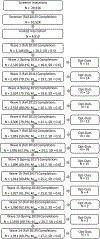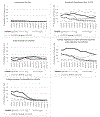Longitudinal latent class analysis of tobacco use and correlates among young adults over a 10-year period
- PMID: 35533571
- PMCID: PMC9554793
- DOI: 10.1016/j.drugalcdep.2022.109474
Longitudinal latent class analysis of tobacco use and correlates among young adults over a 10-year period
Erratum in
-
Corrigendum to "Longitudinal latent class analysis of tobacco use and correlates among young adults over a 10-year period" [Drug Alcohol Depend. 236 (2022) 109474].Drug Alcohol Depend. 2022 Oct 1;239:109593. doi: 10.1016/j.drugalcdep.2022.109593. Epub 2022 Aug 17. Drug Alcohol Depend. 2022. PMID: 35987084 No abstract available.
Abstract
Introduction: We assessed patterns and correlates, including demographic characteristics, psychological factors, and social role transitions, of young adults' tobacco use over time.
Methods: In the fall of 2010, we recruited a cohort of 3146 students from 11 colleges in North Carolina and Virginia. Participants completed baseline and at least two survey waves between 2010 and 2019.
Results: The sample was 49.8% female, 15.7% non-white, and 6.6% Hispanic. Longitudinal latent class analysis revealed a five-class model with distinct patterns and correlates of tobacco use. Limited Use (52.6% of sample) had minimal use. College-Limited Combustible Tobacco Users (18.6%) had moderate probability of cigarette, cigar, and waterpipe smoking, which decreased to no use post-college. Intermittent Sustained Polytobacco Users (10.9%) had low probability of use that continued post-college. College Polytobacco with Continued Cigarette and E-Cigarette Users (14.5%) had high probability of use of cigarette smoking and increasing probability of e-cigarette, both of which continued post-college. Sustained Polytobacco Users (5.7%) had moderate probability of use of tobacco products across all waves.
Conclusions: Patterns of tobacco use varied considerably. In most classes, tobacco use was highest during freshman year and in three classes, use continued post-college. Prevention activities should focus on first-year students and target those at risk for post-college tobacco use.
Keywords: Longitudinal research; Risk for tobacco use; Youth tobacco use.
Copyright © 2022 Elsevier B.V. All rights reserved.
Conflict of interest statement
Figures
Similar articles
-
Longitudinal Patterns of Multiple Tobacco and Nicotine Product Use Among Texas College Students: a Latent Transition Analysis.Prev Sci. 2019 Oct;20(7):1031-1042. doi: 10.1007/s11121-019-01031-3. Prev Sci. 2019. PMID: 31302841 Free PMC article.
-
Tobacco and Nicotine Product Use Transitions by Race and Ethnicity: Results from a Latent Transition Analysis Using Data from the Truth Longitudinal Cohort (2020-2022).Subst Use Misuse. 2024;59(12):1770-1777. doi: 10.1080/10826084.2024.2374974. Epub 2024 Jul 4. Subst Use Misuse. 2024. PMID: 38963130
-
Patterns and Profiles of Adolescent Tobacco Users: Results From the Virginia Youth Survey.Nicotine Tob Res. 2018 Aug 14;20(suppl_1):S39-S47. doi: 10.1093/ntr/nty032. Nicotine Tob Res. 2018. PMID: 30125014 Free PMC article.
-
Distinct Motives for Use Among Polytobacco Versus Cigarette Only Users and Among Single Tobacco Product Users.Nicotine Tob Res. 2017 Dec 13;20(1):117-123. doi: 10.1093/ntr/ntw284. Nicotine Tob Res. 2017. PMID: 27798088 Free PMC article.
-
Polytobacco, marijuana, and alcohol use patterns in college students: A latent class analysis.Addict Behav. 2016 Aug;59:58-64. doi: 10.1016/j.addbeh.2016.03.034. Epub 2016 Apr 2. Addict Behav. 2016. PMID: 27074202 Free PMC article.
References
-
- Bachman JG, O’Malley PM, Schulenberg JE, Johnston LD, Bryant AL, Merline AC, 2002. Why substance use declines in young adulthood: Changes in social activities, roles, and beliefs. Mahwah, NJ: Lawrence Erlbaum Associates.



